Laravel + AI is transforming how developers handle CRUD (Create, Read, Update, Delete) operations. By combining the power of Laravel, a robust PHP framework, with AI-driven GPT models, repetitive tasks can be streamlined, saving time and reducing errors.
This article explores practical ways to automate CRUD operations, optimize performance, and enhance workflows using Laravel + AI. Whether you’re a beginner or a seasoned developer, these insights will help you level up your projects.
Table of Contents
Why Laravel + AI Matters for Developers
Laravel’s elegant syntax and built-in tools like Eloquent ORM make it a favorite for CRUD operations. Pairing it with AI, specifically GPT models, takes automation to the next level. Imagine generating boilerplate code, optimizing queries, or even predicting user inputs—all with minimal effort. This fusion tackles common pain points like slow development cycles and repetitive coding.
Setting Up Laravel for AI Integration
To get started, ensure your Laravel environment is ready. Install Laravel via Composer with this command:
composer create-project laravel/laravel ai-crud-appNext, integrate an AI API like OpenAI’s GPT. Use Composer to add the HTTP client:
composer require guzzlehttp/guzzleThis sets the stage for seamless Laravel + AI communication. Configure your .env file with an API key:
AI_API_KEY=your-key-hereAutomating CRUD Scaffolding with GPT
Manually writing CRUD controllers, models, and views is time-consuming. With Laravel + AI, you can automate this. Create a custom Artisan command to fetch GPT-generated code. Here’s a shortcut:
php artisan make:command GenerateCrudIn the command file (app/Console/Commands/GenerateCrud.php), add logic to send a prompt to GPT:
$prompt = "Generate a Laravel controller for a Post model with CRUD methods.";
$response = Http::post('https://api.openai.com/v1/completions', [
'prompt' => $prompt,
'max_tokens' => 500,
]);
$code = $response->json()['choices'][0]['text'];
file_put_contents(app_path('Http/Controllers/PostController.php'), $code);Run php artisan generate:crud and watch Laravel + AI build your controller instantly.
Speeding Up Development with Shortcuts
Time-saving tricks are key in development. Laravel + AI can generate migrations too. Prompt GPT with:
“Create a Laravel migration for a posts table with title, body, and timestamps.”
The result might look like this:
Schema::create('posts', function (Blueprint $table) {
$table->id();
$table->string('title');
$table->text('body');
$table->timestamps();
});Run php artisan migrate to apply it. This cuts manual work by half, letting you focus on logic.
Optimizing CRUD Performance
Slow CRUD operations frustrate users. Laravel + AI can help optimize queries. For instance, cache repetitive reads:
$posts = Cache::remember('posts', 600, function () {
return Post::all();
});AI can suggest tweaks like indexing:
Schema::table('posts', function (Blueprint $table) {
$table->index('title');
});This boosts speed, especially after traffic spikes. Check out Laravel’s caching docs for more.
Real-World Use Case: Dynamic Forms
Imagine a blog app where admins create posts via forms. Laravel + AI can auto-generate form fields based on the model. Prompt GPT:
“Generate a Laravel Blade form for a Post model.”
You might get:
<form method="POST" action="/posts">
@csrf
<input type="text" name="title" placeholder="Title">
<textarea name="body" placeholder="Body"></textarea>
<button type="submit">Save</button>
</form>This saves hours of manual coding and ensures consistency.
Advanced CRUD Automation with AI
Beyond basic controllers, Laravel + AI can handle complex tasks. For example, generate validation rules dynamically. Prompt GPT with:
“Create Laravel validation for a Post model with title and body.”
You might get:
$request->validate([
'title' => 'required|string|max:255',
'body' => 'required|string',
]);Add this to your controller’s store method:
public function store(Request $request)
{
$data = $request->validate([...]);
Post::create($data);
return redirect('/posts');
}This ensures robust input handling without manual guesswork.
Smart Query Suggestions from AI
AI can analyze your database and suggest optimizations. For a slow Post::all() query, GPT might recommend pagination:
$posts = Post::paginate(10);Pair it with a Blade loop:
@foreach($posts as $post)
<h3>{{ $post->title }}</h3>
<p>{{ $post->body }}</p>
@endforeach
{{ $posts->links() }}This keeps your app snappy even with large datasets. Learn more in Laravel’s pagination guide.
Handling Errors Gracefully
Automation isn’t perfect—GPT-generated code might have bugs. Use Laravel’s exception handling to catch issues. Wrap AI calls in a try-catch:
try {
$response = Http::post('https://api.openai.com/v1/completions', [...]);
$code = $response->json()['choices'][0]['text'];
} catch (\Exception $e) {
Log::error('AI CRUD generation failed: ' . $e->getMessage());
return 'Error generating code. Try again.';
}This logs failures and keeps your app stable.
Boosting Mobile-Friendliness
With Laravel + AI, ensure your CRUD interfaces work on mobile. AI can generate responsive Blade templates. Prompt:
“Create a mobile-friendly Laravel Blade table for posts.”
Result:
<table style="width:100%; overflow-x:auto;">
<tr><th>Title</th><th>Body</th></tr>
@foreach($posts as $post)
<tr><td>{{ $post->title }}</td><td>{{ $post->body }}</td></tr>
@endforeach
</table>Test it on a mobile emulator to confirm fast load times.
Time-Saving Shortcuts for Pros
Laravel + AI shines with shortcuts. Need a quick API endpoint? Ask GPT:
“Generate a Laravel API route for posts.”
You’ll get:
Route::get('/api/posts', function () {
return Post::all()->toJson();
});Register it in routes/api.php and hit /api/posts—done in seconds. For deeper API tips, check Postman’s Laravel guide.
Solving Pain Points: Slow Performance
If your CRUD app lags, Laravel + AI can pinpoint bottlenecks. AI might suggest eager loading over lazy loading:
$posts = Post::with('comments')->get();This reduces database queries, cutting load times. After a traffic spike, monitor with Laravel Telescope (see docs) and tweak based on AI advice.
Security Considerations
AI-generated code needs scrutiny. Avoid blind execution—review for SQL injection risks. Use Laravel’s built-in protections like:
Post::create($request->only('title', 'body'));This ensures only safe fields are processed, keeping your app secure.
Bringing It All Together
Laravel + AI isn’t just a buzzword—it’s a practical toolkit. From generating CRUD scaffolding to optimizing queries and ensuring mobile-friendliness, this combo saves hours and boosts quality. Start small with a custom Artisan command, then scale to dynamic forms or APIs. The key? Experiment and refine.
FAQs
1: What is Laravel + AI, and how does it work?
Laravel + AI combines the Laravel PHP framework with artificial intelligence, like GPT models, to automate tasks. It works by integrating AI APIs (e.g., OpenAI) into Laravel projects. Developers use prompts to generate code—like CRUD controllers or migrations—saving time and effort while maintaining Laravel’s structure.
2: Can Laravel + AI automate CRUD operations fully?
Yes, Laravel + AI can automate most CRUD (Create, Read, Update, Delete) operations. By using AI to generate models, controllers, and views, you reduce manual coding. However, you should review AI outputs for accuracy and tweak them to fit your project’s specific needs.
3: How do I set up Laravel + AI for my project?
Start by installing Laravel with composer create-project laravel/laravel your-app. Add an HTTP client like Guzzle (composer require guzzlehttp/guzzle), then configure an AI API key in your .env file. Create custom Artisan commands to call the AI and generate CRUD code—it’s that simple!
4: Does Laravel + AI improve performance?
Absolutely! Laravel + AI can optimize CRUD performance by suggesting caching (e.g., Cache::remember), query tweaks like pagination, or indexing. These improvements reduce load times and handle traffic spikes better, making your app faster and more reliable.
5: Is Laravel + AI suitable for beginners?
Yes, Laravel + AI is beginner-friendly. Laravel’s clear syntax paired with AI’s ability to generate boilerplate code lowers the learning curve. Start with basic automation (like migrations) and scale up as you get comfortable—perfect for new and experienced developers alike.
6: What are the risks of using Laravel + AI?
While Laravel + AI speeds up development, risks include buggy AI-generated code or security flaws like SQL injection. Always review outputs, use Laravel’s built-in protections (e.g., $request->only), and test thoroughly to ensure your app stays secure and stable




